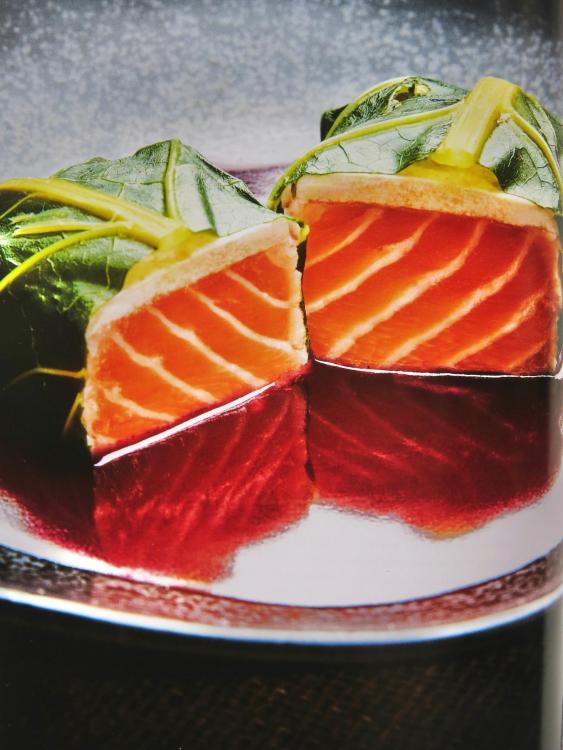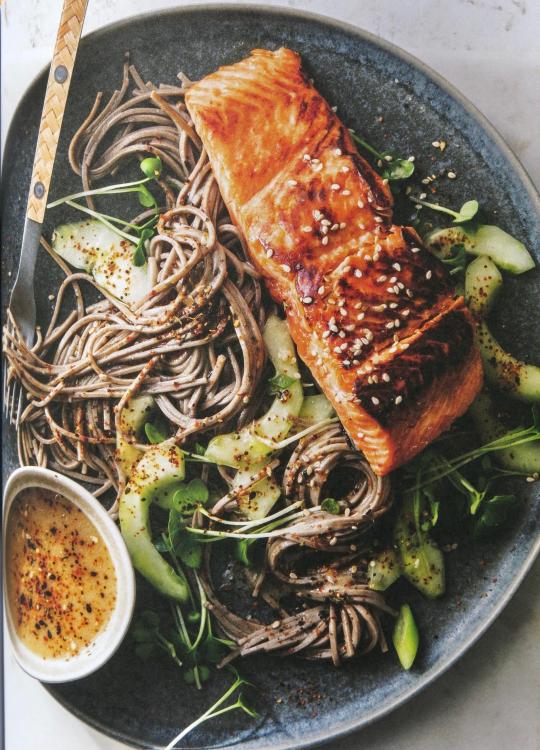I recently purchased 2 fish and seafood cookbooks and this older topic seems like a good place to mention them.
Eric Ripert's Seafood Simple: A Cookbook (eG-friendly Amazon.com link) came out in October 2023. I think simple is the key word to describe this book. The recipes are fairly simple, elegantly plated with spare, zoomed-in photos and the background information on fish and seafood species and sustainability is scant and superficial. This book makes me want to go out to a fine-dining restaurant.
The second book, The Hog Island Book of Fish & Seafood: Culinary Treasures from Our Waters (eG-friendly Amazon.com link) by John Ash came out in May 2023 and is almost encyclopedic by comparison in terms of the number of species used and the space given to describing them. Photos are more zoomed-out images of casually-plated fare printed on matte paper. This book makes me want to cook.
Seafood Simple: A Cookbook (eG-friendly Amazon.com link) is full of beautiful photos of artfully plated food, printed on glossy paper and there are lots of great reviews for it on Amazon. There are photos of most, if not all recipes. It's 286 pages long and Eat Your Books tells me there are 99 recipes, 8 of which are "how-tos" like how to clean shrimp or remove pin bones.
Recipes are organized by cooking method: Raw, Steamed, Poached, Fried, Baked, Sautéed, Broiled, Broiled, Grilled and a very brief section on Preserved fish. He doesn't use a huge variety of fish. Salmon shows up in every chapter. I'm not sure how good the index is. Neither black cod nor sablefish are listed in the index although the recipe for Miso Cod "Nobu" lists black cod in the ingredients.
He gives a brief nod to sustainability and recommends consulting the NOAA (National Oceanic and Atmospheric Administration) for US readers but doesn't go much deeper than that. While the recipes generally recommend similar fish that would work well, he doesn't go into the admittedly confusing area of fish names and where they might be sourced from. I suppose that's quite appropriate for a book trying to appeal to an audience looking for something simple.
The recipes themselves are pretty straightforward, though a certain amount of skill and razor sharp knives will be needed to produce results similar to the photos. For example this dish of Salmon Wrapped in Collard Greens with Beurre Rouge consists of salmon filets, topped with thin slices of raw button mushrooms, wrapped in blanched collard greens, steamed, cut in half and plated atop a beurre rouge. I think he's actually used the suggested alternate of Swiss chard in the photo in the book. He doesn't say anything about trimming the thickness of the central stalk, though it looks like that has been done.
Photo above included for review purposes to demonstrate the sort of zoomed in photos used throughout the book and how beautifully this simple dish can be presented by someone who knows what they are doing with a sharp knife. I'm sure I'd have mushroom slices sliding out, squashed fish and raggedy collard fibers.
I thought the chapter introductions might offer some helpful tips and tricks for the different cooking methods, but they really don't. Throughout the book, he says to gauge doneness by sticking a skewer into the fish and holding it to your wrist (though the photo in the baking section shows the chef holding the skewer to his hand, not wrist) but I couldn't find any tips on how one might educate themselves on this method.
The Hog Island Book of Fish & Seafood: Culinary Treasures from Our Waters (eG-friendly Amazon.com link) by John Ash was recommended by one of the co-owners of the fish share service I've been using. She received it as a gift last year and has enjoyed using it. There are relatively few reviews for it on Amazon and they all seem pretty brief but they're positive. At 351 pages, it's quite a tome. Eat Your Books tells me the book contains 306 recipes, 32 of which are "how tos" like clam and oyster shucking. I'd say somewhat less than half of the recipes appear in photographs which are printed on matte paper, something I know annoys some people, though not me.
The recipes are organized by fish type: Mollusks, Cephalopods, Crustaceans, the Salmon Family, Other Finned Fish, Halibut and Other Flatfish, Big Meaty Fish, Little Fish, Canned, Tinned and Jarred Fish, and Other Gifts from the Sea (caviar and roe, sea urchins, seaweed and sea vegetables). As one might expect from a book named for a business (Hog Island Oyster Co) that's on the supply-side and well-known for its sustainable practices and environmentalism, there's a lot more background on choosing and purchasing fish and seafood with sustainability in mind. Each chapter includes background information on the species covered, and does a good job parsing out the often confusing nomenclature. It uses clear, simple pen & ink diagrams to demonstrate prep techniques used for the species covered in each chapter. The recipes themselves are clearly written and include a good mix of soups, salads, pastas, risotto, etc. as compared with Seafood Simple, where a majority of the recipes seem to be a fish plus a sauce.
As mentioned, the photos are zoomed-out images of casually (even messily) plated food. The image below accompanies the recipe for Ginger-Soy Salmon with Soba Noodle Salad.
Photo above included for review purposes to demonstrate the photography style in The Hog Island Book of Fish & Seafood.
I expect this book will be an excellent reference for me and the casual recipes are a better fit for my style of cooking. I'd highly recommend it to someone wanting to get into fish or seafood cookery with something a bit fresher and maybe less intimidating than Peterson.
I'm debating returning Seafood Simple but The Hog Island Book of Fish & Seafood is a keeper for me.
Edited to add that I just saw how long this post is 🫢. Sorry for going on and on!





